Related Research Articles

Wartrace is a town in Bedford County, Tennessee. The population was 653 at the 2020 census. It is located northeast of Shelbyville. The downtown area is listed on the National Register of Historic Places as the Wartrace Historic District.

The Morgan horse is one of the earliest horse breeds developed in the United States. Tracing back to the foundation sire Figure, later named Justin Morgan after his best-known owner, as well as mares of the now-extinct Narragansett Pacer breed, Morgans served many roles in 19th-century American history, being used as coach horses and for harness racing, as general riding animals, and as cavalry horses during the American Civil War on both sides of the conflict. Morgans have influenced other major American breeds, including the American Quarter Horse, the American Saddlebred, the Tennessee Walking Horse, and the Standardbred.

The Tennessee Walking Horse or Tennessee Walker is a breed of gaited horse known for its unique four-beat running-walk and flashy movement. It was originally developed as a riding horse on farms and plantations in the American South. It is a popular riding horse due to its calm disposition, smooth gaits and sure-footedness. The Tennessee Walking Horse is often seen in the show ring, but is also popular as a pleasure and trail riding horse using both English and Western equipment. Tennessee Walkers are also seen in movies, television, and other entertainment.

The Narragansett Pacer was one of the first recorded horse breeds developed in the United States. It emerged in the 18th century (1700s), and was theorized to have been bred from a mix of English and Spanish breeds, although the exact cross is unknown. The Pacer was associated with, and bred in, the state of Rhode Island and the area of New England; as horse breeding shifted to Kentucky and Tennessee in the late 1700s, it became extinct by the 20th century.

The Canadian is a horse breed from Canada. It is a strong, well-muscled horse, usually dark in colour. It is generally used for riding and driving. Descended from draft and light riding horses imported to Canada in the late 1600s from France, it was later crossed with other British and American breeds. During the 18th century the Canadian horse spread throughout the northeastern US, where it contributed to the development of several horse breeds. During the peak popularity of the breed, three subtypes could be distinguished, a draft horse type, a trotting type and a pacing type. Thousands of horses were exported in the 19th century, many of whom were subsequently killed while acting as cavalry horses in the American Civil War. These exports decreased the purebred Canadian population almost to the point of extinction, prompting the formation of a studbook and the passage of a law against further export.

The heavy warmbloods are a group of horse breeds primarily from continental Europe. The title includes the Ostfriesen and Alt-Oldenburger ("Old-Oldenburger"), Groningen, and similar horses from Silesia, Saxony-Thuringia, and Bavaria. Breeds like the Hungarian Nonius, Kladruber, and Cleveland Bay are also often classed as "heavy warmbloods." They are the ancestors of the modern warmbloods, and are typically bred by preservation groups to fit the pre-World War I model of the all-purpose utility horse. Unlike the registries of the sport horses that followed them, many heavy warmblood registries maintain closed or partly closed studbooks. However, external evaluation and performance testing of the breeding stock is still a key element in these registries. Many of the heavy warmbloods are selected primarily for family-friendly temperaments.

Black Allan or Allan F-1 was the foundation sire of the Tennessee Walking Horse. He was out of a Morgan and Thoroughbred cross mare named Maggie Marshall, a descendant of Figure and the Thoroughbred racing stallion Messenger; and sired by Allandorf, a Standardbred stallion descended from Hambletonian 10, also of the Messenger line.
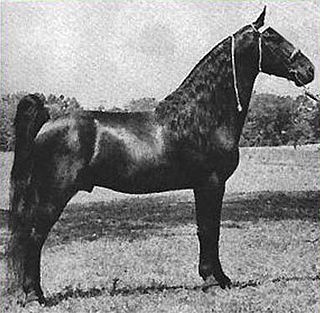
Midnight Sun (1940–65) was one of the leading sires of the Tennessee Walking Horse breed, and a two-time World Grand Champion in 1945 and 1946. He was trained by Fred Walker and lived almost all his life at Harlinsdale Farm in Franklin, Tennessee.

The Mountain Pleasure Horse is a breed of gaited horse that was developed in the Appalachian Mountains of Eastern Kentucky. This breed reflects the primitive Appalachian gaited horse type and genetic testing shows them to share ancestry with earlier breeds developed in the region, including the American Saddlebred, the Tennessee Walking Horse and the Rocky Mountain Horse. Some Mountain Pleasure Horse bloodlines are traceable for over 180 years.
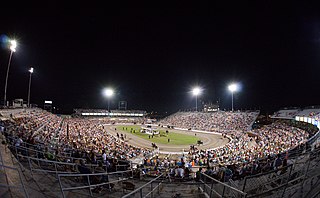
The Tennessee Walking Horse National Celebration (TWHNC), sometimes known as the Celebration, is the largest horse show for the Tennessee Walking Horse breed, and has been held annually in or near Shelbyville, Tennessee since its inception in 1939. The Celebration was conceived by Henry Davis, a horse trainer who along with several other horsemen, felt the Shelbyville area should have a festival or annual event. Although the Celebration was originally held in Wartrace, Tennessee, it moved to Shelbyville, the seat of Bedford County, a few years later. The Celebration spans 11 days and nights in late August and early September annually, and finishes with the crowning of the World Grand Champion Tennessee Walker on the Saturday night before Labor Day. The TWHNC draws an estimated 2,000 horses and 250,000 spectators to Shelbyville each year.
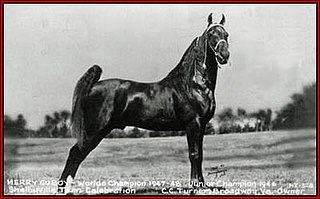
Merry Go Boy was a highly influential Tennessee Walking Horse sire and two-time World Grand Champion. He is credited for producing the most desirable conformation type in his offspring.
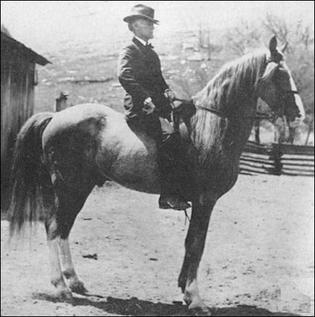
Roan Allen (1904–1930) was one of the founding sires of the Tennessee Walking Horse. It is believed that all Tennessee Walking Horses alive today trace back to him.
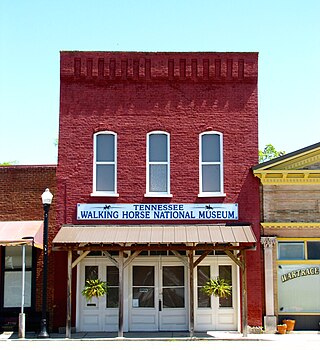
The Tennessee Walking Horse National Museum is the only museum dedicated entirely to the Tennessee Walking Horse. It is located in downtown Wartrace, Tennessee, and contains exhibits on all aspects of the Walking Horse industry.
Wilson's Allen (1914–1939) was an influential early Tennessee Walking Horse sire. Although he himself was not used as a show horse, he sired the first three World Grand Champions of his breed.

Merry Legs (1911–1932) was a Tennessee Walking Horse mare who was given foundation registration for her influence as a broodmare. She was also a successful show horse.
Steve Hill was a Tennessee Walking Horse trainer. He is one of only three horse trainers to win the breed's World Grand Championship four times, and trained the first three-time winner.

Winston Wiser (1910–1961) was a Tennessee Walking Horse trainer from Shelbyville, Tennessee, who won five World Grand Championships on three separate horses.
Charles Emmett Brantley was a Tennessee Walking Horse breeder. He grew up on a farm in Coffee County, Tennessee and competed in the first Tennessee Walking Horse National Celebration. Besides breeding horses, he was a horse trainer for several years, but quit riding due to health issues. He was married to his wife Nellie for 70 years, and was inducted into both the Tennessee Walking Horse Hall of Fame and the Tennessee Sports Hall of Fame.

The horse industry in Tennessee is the 6th largest in the United States, and over 3 million acres of Tennessee farmland are used for horse-related activities. The most popular breed in the state is the Tennessee Walking Horse - developed by crossing Thoroughbred, Morgan, Saddlebred, and Standardbred horses in the 19th and 20th centuries - and it became an official state symbol in 2000.
Pride of Midnight (1966-1979) was a Tennessee Walking Horse who had a short career as a show horse but became very notable as a sire in his breed.
References
- 1 2 3 "Association". Twhbea.com. Archived from the original on 2015-12-08. Retrieved 2015-12-19.
- ↑ Judith Dutson (7 May 2012). Storey's Illustrated Guide to 96 Horse Breeds of North America. Storey Publishing, LLC. p. 246. ISBN 9781603429184 . Retrieved 2015-12-19.
- ↑ "100 Years Of Walking In Wartrace". Twhbea.com. Archived from the original on 2016-03-04. Retrieved 2015-12-19.
- ↑ "Dement Home Place".